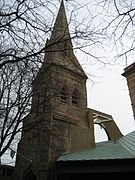
First Church in Boston
First Church in Boston is a Unitarian Universalist Church (originally Congregationalist) founded in 1630 by John Winthrop's original Puritan settlement in Boston, Massachusetts. The current building, located on 66 Marlborough Street in the Back Bay neighborhood, was designed by Paul Rudolph in a modernist style after a fire in 1968. It incorporates part of the earlier gothic revival building designed by William Robert Ware and Henry Van Brunt in 1867. The church has long been associated with Harvard University.
History[edit]
The church congregation was established in 1630, when the settlers on the Arbella arrived at the site of present-day Charlestown, Massachusetts.[1] John Wilson was the first minister, and the only minister while the church was in Charlestown. Two years later they constructed a meeting house across the Charles River near what is now State Street in Boston, and Wilson was officially installed as minister there. In 1633 John Cotton arrived from England, and was a teaching elder at the church, helping to establish the foundation of the Congregational Church, the official state church of Massachusetts. In 1677 Dorcas ye blackmore, a freed slave, became the first African American allowed to become a member of the church.[2] In the 18th century, Charles Chauncy was a minister at First Church for sixty years,[3] where he gained a reputation for opposing what he believed was the emotionalism of Jonathan Edwards during the Great Awakening.[4]
A schism developed at the turn of the 19th century: this Trinitarian Christian church eventually transformed into a Unitarian congregation by the mid-19th century, as did many of the other state churches in Massachusetts.[5] Massachusetts' state churches (largely Unitarian and Congregationalist, including First Church), were officially disaffiliated from the government in 1833.
In the 19th century, the First Church moved to Back Bay in Boston. The building at 66 Marlborough Street in Boston dated from 1868, and was designed by Boston architects William Robert Ware and Henry Van Brunt.
Second Church, also known as the "Church of the Mathers", was founded in 1649 when the population spread to the North End and justified an additional congregation sited closer to those individuals' homes. From 1664 to 1741, its clergy consisted of Increase Mather, Cotton Mather, and Samuel Mather. Both churches were examples of the westward movement of Boston churches from the crowded, older downtown area to the newer, more fashionable Back Bay. This area was developed for residential use after lowlands were filled in during the late 19th and early 20th centuries. Second Church's Back Bay location in the Fenway was sold (it is now owned by the Ruggles St. Baptist congregation) just before the merger.[6]
After a disastrous fire in 1968, First Church and Second Church merged and built a new building at the 66 Marlborough Street location.
The current building incorporates the ruined street facade and "puddingstone" steeple tower of the previous church on the site (by Ware & van Brunt, 1868), which had burned in 1968.[7][8] After a call for designs, the congregation voted for the proposal by Paul Rudolph, which was completed in 1972.[8]
The light-flooded, soaring interior is finished with Rudolph's characteristic bush hammered "corduroy concrete" surfaces. Decades later, the interiors are immaculately preserved. Great care has been taken not to permanently change the walls, and to reproduce the original textile decorations.[9]








